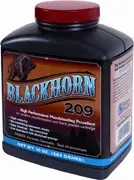|
NEWS FLASH: Blackhorn 209 is not Black Powder; it is a Black Powder Substitute! By Chuck Hawks  A Guns and Shooting Online contributor wrote to me today (June 21, 2010), to tell me that: "The law enforcement divisions of New Mexico Department of Game and Fish and Colorado Dept. of Natural Resources are reviewing analyses of Blackhorn 209 and when they confirm that it is a nitrocellulose base powder, they will issue public notices that it is illegal to hunt with it in their states." My immediate reaction was, so what if Blackhorn 209 is nitrocellulose based? These two game departments are apparently guilty of a stupid, unreasoning prejudice (against an inanimate chemical compound, no less!). Why else would they ban one perfectly good black powder substitute and not the others? All of them are NOT black powder and they are all corrosive to some degree (Blackhorn 209 reportedly less so than others), so I fail to see the distinction. There is nothing inherently wrong with nitrocellulose based powders and a great deal that is right, whether loaded from the muzzle or the breech end of a rifle barrel. That is why nitrocellulose powders had largely replaced dirty, extremely corrosive and dangerously explosive black powder by the end of the 19th Century. The great majority of modern muzzleloading hunters do not shoot actual black powder; they use "black powder substitutes." None of these are chemically similar to organic black powder. As I write these words, Blackhorn 209 is arguably the best and most efficient of these black powder substitutes. What does it matter if it is nitrocellulose based? Nitrocellulose based powders were the original black powder substitute, introduced well over 100 years ago and long before modern black powder substitutes became popular. To the best of my knowledge, there has never been any law prohibiting a nitrocellulose based black powder substitute. (If there had been, none of today's modern powders could have been developed!) I have also recently read criticism of Blackhorn 209 for not having its chemical composition printed on the container, the unspoken implication apparently being that Western Powders (producer of Blackhorn 209) is concealing something scandalous. (Of course, the Blackhorn 209 patent application lists its chemical composition and that is a matter of public record.) Does any black powder substitute advertise its chemical composition on the container? I just checked a bottle of Triple Se7en (probably the leading black powder substitute prior to the introduction of Blackhorn 209) and nowhere does it mention the chemical composition. It does say that Triple Se7en is not classed as an explosive and, while not smokeless powder, it is okay to ship and store Triple Se7en as smokeless powder (per DOT regulations). Thus, I am forced to wonder, why has Blackhorn 209 suddenly been singled out for this attention? Perhaps the real reason Blackhorn 209 has inspired the ire of the ultra-reactionary "buckskin lobby" is because it is too good. |